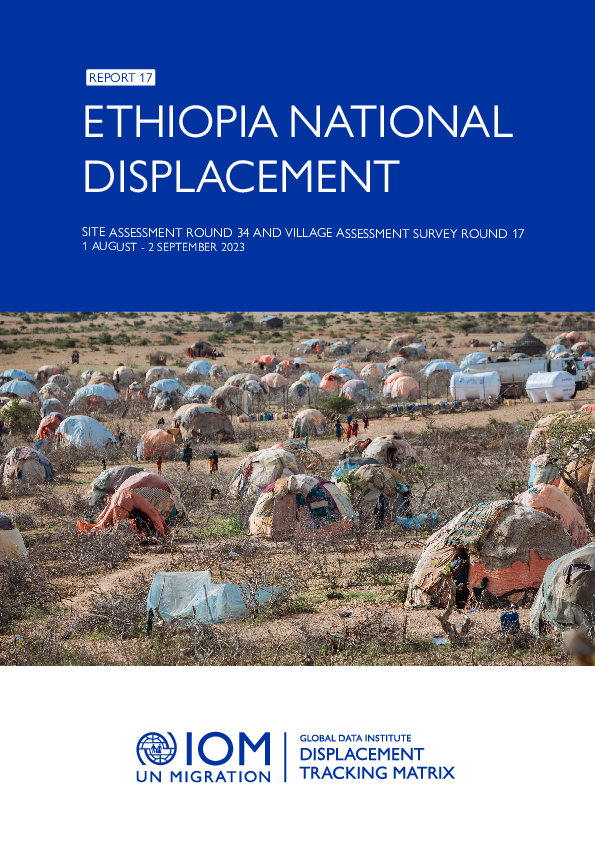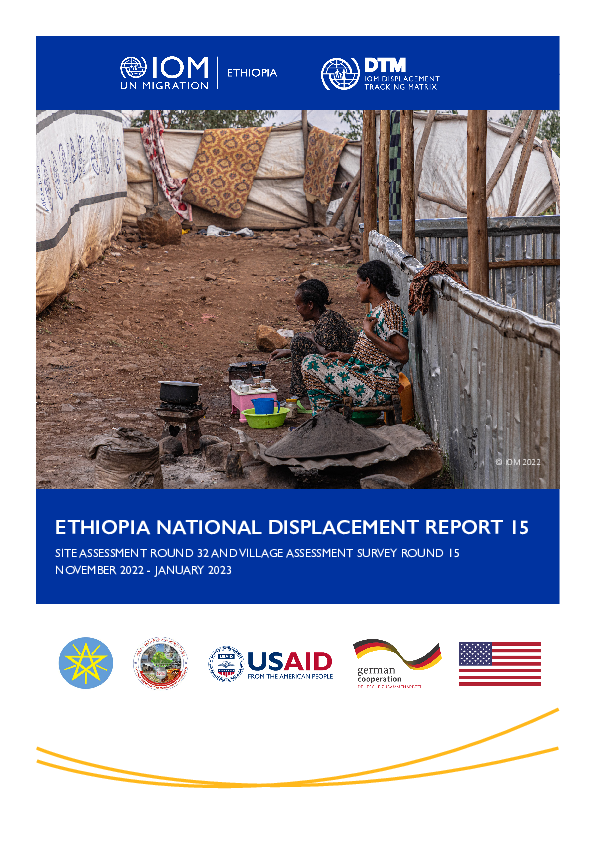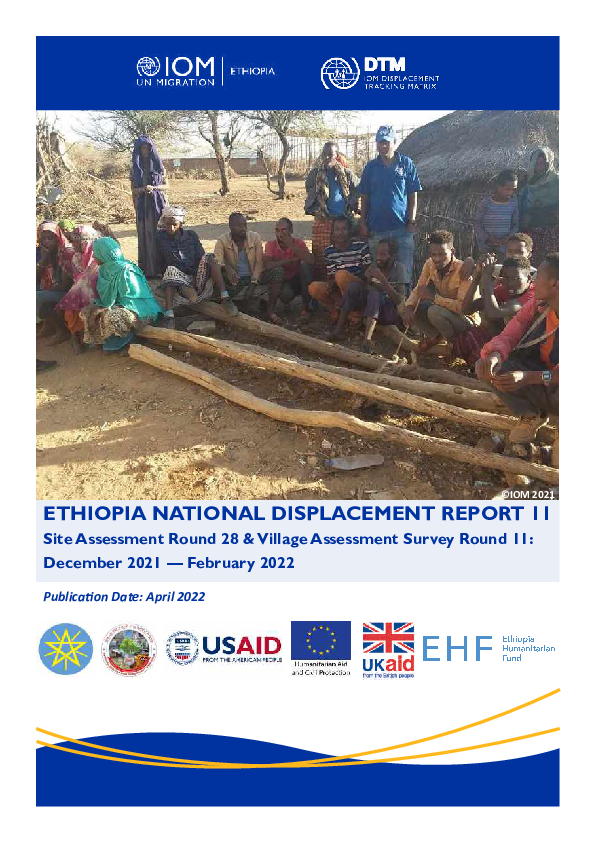-
Countries
-
Data and Analysis
-
Special Focus
-
Crisis Responses
National Displacement Report
Country
Title Standard
Ethiopia — National Displacement Report # (DATE)
Operation
Contact
DTM Ethiopia, DTMEthiopia@iom.int
Type
Component
Domain
Confidential

Contact
DTM Ethiopia, DTMEthiopia@iom.int
Language
English
Location
Ethiopia
Period Covered
Nov 23 2023
May 01 2024
Activity
- Mobility Tracking
- Site Assessment
- Village Assessment
Between April and May 2024, IOM DTM deployed the SA round 36 and VAS round 19, in 11 regions across Ethiopia. The November - December 2023 data (Round 35 for SA and Round 18 for VAS) was compiled with the April - May 2024 data (Round 36 for SA and Round 19 for VAS) to consolidate national IDP and returning IDP figures updated to May 2024. The locations assessed during both rounds of data collection are not duplicated in the consolidated figures.
As of May 2024, an estimated 664,509 households comprising 3,306,693 IDPs were identified in 2,739 accessible sites across Ethiopia. Conflict was the primary reason for displacement reported nationally (68.7%), followed by drought (16.5%) (8.4%). Somali region hosts the highest number of IDPs primarily displaced by drought nationwide (an estimated 397,913 individuals or 73.1% of the national drought caseload), while Tigray region hosts the highest number of IDPs primarily displaced by conflict nationwide (an estimated 871,056 individuals or 38.3% of the national conflict caseload).
According to the data collected through the Village Assessment Survey, an estimated 593,543 returning IDP households comprising 2,584,607 returning IDPs were identified in 2,651 accessible villages across Ethiopia. Tigray region hosts the highest number of reported returning IDPs (an estimated 970,265 returning IDPs or 37.5% of the national caseload). This is followed by Amhara region (an estimated 951,931 returning IDPs or 36.8% of the national caseload) and Afar region (an estimated 223,313 returning IDPs or 8.6% of the national caseload).
It is to be noted that South Ethiopia region is not included due to operational constraints.

Contact
DTM Ethiopia, DTMEthiopia@iom.int
Language
English
Location
Ethiopia
Period Covered
Jul 01 2019
Jan 08 2023
Activity
- Mobility Tracking
- Site Assessment
- Village Assessment
The objective of this thematic report is to provide an overview of the International Organization for Migration (IOM)'s Data and Research Unit (DRU) data collected through its Displacement Tracking Matrix (DTM) methodology and Site Assessment (SA) and Village Assessment Survey (VAS) tools deployed at the location level in Ethiopia between July 2019 and January 2023. Through the SA, sites hosting at least 20 IDP households are assessed and, through the VAS, villages hosting at least 20 returning IDP households are assessed.
This overview gathers and analyzes specific data records on displacement and returns related to drought and other climate-induced factors such as floods, landslides and fires.

Contact
DTM Ethiopia, DTMEthiopia@iom.int
Language
English
Location
Ethiopia
Period Covered
Nov 23 2023
Dec 31 2023
Activity
- Survey
- Mobility Tracking
- Site Assessment
- Village Assessment
Between November and December 2023, IOM’s DTM deployed Site Assessment (SA) Round 35 and Village Assessment Survey (VAS) Round 18.
According to data collected through the Site Assessment round 35 November and December 2023, an estimated 3,194,413 IDPs (635,724 IDP households) were internally displaced across 2,662 assessed, accessible sites in Ethiopia. Conflict is the primary cause of displacement and displaced almost 2.2 million IDPs (68.7%), followed by drought which displaced an estimated 536,343 IDPs (16.8%). Somali region hosts the highest number of IDPs primarily displaced by drought nationwide (an estimated 391,573 individuals or 73% of the national drought caseload), while Tigray region hosts the highest number of IDPs primarily displaced by conflict nationwide (an estimated 831,002 individuals or 37.9% of the national conflict caseload).
According to the data collected through the Village Assessment Survey round 18 between November and December 2023, there were an estimated 2,548,685 returning IDPs (586,187 returning IDP households) across 2,580 assessed, accessible villages in Ethiopia. The highest returning IDP caseloads nationwide were in the regions of Tigray (967,257 returning IDPs, 38%), Amhara (an estimated 951,931 returning IDPs, 37.3%) and Afar (an estimated 222,179 returning IDPs, 8.7%).
It is to be noted that South Ethiopia region is not included due to operational constraints. Furthermore, the dataset for Amhara region is available separately, as a multisectoral location assessment was carried out within the region.

Contact
DTM Ethiopia, DTMEthiopia@iom.int
Language
English
Location
Ethiopia
Period Covered
Aug 01 2023
Sep 02 2023
Activity
- Mobility Tracking
- Site Assessment
- Village Assessment
Between August and September 2023, IOM’s DTM deployed Site Assessment (SA) Round 34 and Village Assessment Survey (VAS) Round 17, carrying out a multisectoral location assessment. It is to be noted that Amhara region was largely uncovered this round due to increased insecurity, and both the IDP and returning IDP caseloads should likely be higher.
According to data collected through the Site Assessment round 34 August and September 2023, an estimated 3,459,881 IDPs (701,449 IDP households) were internally displaced across 2,544 assessed, accessible sites in Ethiopia. Conflict is the primary cause of displacement and displaced 2.2 million IDPs (64.66%), followed by drought which displaced an estimated 612,250 IDPs (17.7%). Somali region hosts the highest number of IDPs primarily displaced by drought nationwide (an estimated 410,749 individuals or 67.1% of the national drought caseload), while Tigray region hosts the highest number of IDPs primarily displaced by conflict nationwide (an estimated 943,285 individuals or 42.2% of the national conflict caseload).
According to the data collected through the Village Assessment Survey round 17 between August and September 2023, there were an estimated 2,530,101 returning IDPs (552,773 returning IDP households) across 2,072 assessed, accessible villages in Ethiopia. The highest returning IDP caseloads nationwide were in the regions of Tigray (1,503,141 returning IDPs, 59.41%), Amhara (an estimated 389,937 returning IDPs, 15.41%) and Afar (an estimated 222,894 returning IDPs, 8.81%).

Contact
DTM Ethiopia, DTMEthiopia@iom.int
Language
English
Location
Ethiopia
Period Covered
Nov 25 2022
Jun 29 2023
Activity
- Mobility Tracking
- Site Assessment
- Village Assessment
Between April and June 2023, IOM DTM deployed Site Assessment (SA) Round 33 and Village Assessment Survey (VAS) Round 16, carrying out a multisectoral location assessment in Tigray region, and a figure update in selected high mobility locations across the rest of Ethiopia. The November 2022 - January 2023 data (Round 32 for SA and Round 15 for VAS) was compiled with the April - June 2023 data (Round 33 for SA and Round 16 for VAS) to consolidate national IDP and returning IDP figures updated to June 2023. The locations assessed during both rounds of data collection are not duplicated in the consolidated figures.
As of June 2023, 4,385,789 IDPs (872,483 IDP households) were internally displaced across 3,393 assessed, accessible sites in Ethiopia. Conflict is the primary cause of displacement and displaced 2.9 million IDPs (66.41%), followed by drought which displaced 810,855 IDPs (18.49%). Somali region hosts the highest number of IDPs primarily displaced by drought nationwide (542,807 individuals or 66.94% of national drought caseload), while Tigray region hosts the highest number of IDPs primarily displaced by conflict nationwide (1,011,636 individuals or 34.73% of national conflict caseload).
As of June 2023, IOM DTM estimated 3,238,803 returning IDPs (737,873 returning IDP households) across 2,754 assessed, accessible villages in Ethiopia. The highest returning IDP caseloads nationwide were in the regions of Amhara (1,422,074 returning IDPs, 43.91%), Tigray (1,256,297 returning IDPs, 38.79%) and Afar (194,968 returning IDPs, 6.02%).

Contact
DTM Ethiopia, DTMEthiopia@iom.int
Language
English
Location
Ethiopia
Period Covered
Nov 25 2022
Feb 09 2023
Activity
- Mobility Tracking
- Site Assessment
- Village Assessment
In order to capture the displacement and return dynamics in Ethiopia, DTM Ethiopia's National Displacement Report combines findings from its Site Assessment (SA) in Section 1 and findings from the Village Assessment Survey (VAS) in Section 2. The Site Assessment tracks the number of internally displaced persons (IDPs), while the Village Assessment Survey tracks the number of IDPs who are returning or have returned to their communities.
According to data collected through the Site Assessment round 32 between November 2022 and January 2023, 3.14 million IDPs (579,672 households) were internally displaced across 2,472 accessible sites in Ethiopia. Tigray region was covered in this round but data was shared separately.
According to the data collected through the Village Assessment Survey round 15 between November 2022 and January 2023, there were an estimated 1.89 million returning IDPs (424,162 households) across 1,727 villages in Ethiopia. Tigray region was covered in this round but data was shared separately.

Contact
DTM Ethiopia, DTMEthiopia@iom.int
Language
English
Location
Ethiopia
Period Covered
Aug 08 2022
Sep 17 2022
Activity
- Mobility Tracking
- Site Assessment
- Village Assessment
In order to capture the displacement and return dynamics in Ethiopia, DTM Ethiopia's National Displacement Report combines findings from its Site Assessment (SA) in Section 1 and findings from the Village Assessment Survey (VAS) in Section 2. The Site Assessment tracks the number of internally displaced persons (IDPs), while the Village Assessment Survey tracks the number of IDPs who are returning or have returned to their communities.
According to data collected through the Site Assessment round 31 in August and September 2022, 2.73 million IDPs (517,201 households) were internally displaced across 2,200 accessible sites in Ethiopia. This reflects a +0.43% increase compared to the previous round of data collection in June and July 2022. Due to operational constraints, the figure for Tigray region is not included in the national total.
According to the data collected through the Village Assessment Survey round 14 between August and September 2022, there were an estimated 1.88 million returning IDPs (437,077 households) across 1,554 villages in Ethiopia. This represents a -6% decrease compared to the previous round of data collection in June and July 2022. Due to operational constraints, the figure for Tigray region is not included in the national total.

Contact
DTM Ethiopia, SLOAddisAbabaDTM@iom.int
Language
English
Location
Ethiopia
Period Covered
Jun 01 2022
Jul 31 2022
Activity
- Mobility Tracking
- Site Assessment
In order to capture the displacement and return dynamics in Ethiopia, DTM Ethiopia's National Displacement Report combines findings from its Site Assessment (SA) in Section 1 and findings from the Village Assessment Survey (VAS) in Section 2. The Site Assessment tracks the number of internally displaced persons (IDPs), while the Village Assessment Survey tracks the number of IDPs who are returning or have returned to their communities.
According to data collected through the Site Assessment round 30 in June and July 2022*, 2.72 million IDPs (522,138 households) were internally displaced across 2,120 accessible sites in Ethiopia. Due to operational constraints, the figure for Tigray region is not included in the national total. This reflects a -1.58% decrease of 43,618 IDPs compared to the previous round of data collection in March and April 2022.
According to the data collected primarily between June and July 2022*, there were an estimated 2 million returning IDPs (456,120 households) across 1,662 villages in Ethiopia. Due to operational constraints, the figure for Tigray region is not included in the national total. The increase in the number of returning IDPs can be attributed to the increase in coverage this round, especially in villages in Amhara region.
*Due to the greater IDP caseload, data collection in Amhara and Oromia regions began in May 2022.

Contact
DTM Ethiopia, SLOAddisAbabaDTM@iom.int
Language
English
Location
Ethiopia
Period Covered
Mar 01 2022
Apr 18 2022
Activity
- Mobility Tracking
- Site Assessment
- Village Assessment
In order to capture the displacement and return dynamics in Ethiopia, DTM Ethiopia's National Displacement Report combines findings from its Site Assessment (SA) in Section 1 and findings from the Village Assessment Survey (VAS) in Section 2. The Site Assessment tracks the number of internally displaced persons (IDPs), while the Village Assessment Survey tracks the number of IDPs who are returning or have returned to their communities.
As of April 2022, a total of 2.75 million IDPs have been identified in 2,158 accessible sites across 11 regions in Ethiopia. As a note, due to operational constraints, figures from Tigray region were not included in the total. Of the displaced population, the main causes of displacement were conflict which displaced 1.78 million IDPs (65%), drought which displaced 581,952 IDPs (21%), social tension which displaced 150,576 IDPs (5%), flash floods which displaced 107,816 IDPs (4%) and seasonal floods which displaced 94,118 IDPs (3%).
Through Village Assessment Survey round 12 (March-April 2022), a total of 1.66 million returning IDPs were identified in 1,403 villages across 9 regions (data collection was not undertaken in Tigray region due to a lack of fuel and cash). 1.6 million returning IDPs (97%) were initially displaced due to conflict, 22,107 returning IDPs (1%) were initially displaced due to seasonal floods, 17,178 returning IDPs due to flash floods (1%), 3,439 returning IDPs due to landslides (<1%) and 737 returning IDPs due to fire (<1%).

Contact
DTM Ethiopia, SLOAddisAbabaDTM@iom.int
Language
English
Location
Ethiopia
Period Covered
Dec 01 2021
Feb 15 2022
Activity
- Site Assessment
- Mobility Tracking
- Village Assessment
In order to capture the displacement and return dynamics in Ethiopia, DTM Ethiopia's National Displacement Report combines findings from its Site Assessment (SA) in Section 1 and findings from the Village Assessment Survey (VAS) in Section 2. The Site Assessment tracks the number of internally displaced persons (IDPs), while the Village Assessment Survey tracks the number of IDPs who are returning or have returned to their communities.
As of February 2022, a total of 4.51 million IDPs have been identified thus far across the country. Of the total displaced population, the main causes of displacement were conflict which displaced 3.63 million IDPs (81%), drought which displaced 420,887 IDPs (9%), social tension which displaced 171,727 IDPs (4%), seasonal floods which displaced 122,901 IDPs (3%) and flash floods which displaced 119,807 IDPs (3%).
Through Site Assessment round 28 (Dec 2021-Jan 2022), 2.06 million IDPs were identified in 1,440 IDP sites across 9 regions in Ethiopia. Notably, there was a +37% increase in the number of drought IDPs this round due to the intensifying drought, especially in Afder, Dawa, Dollo and Liban zones in Somali region and West Guji zone in Oromia region. Through Emergency Site Assessment round 9 (Jan-Feb 2022), 175,264 IDPs were identified across 83 IDP sites in Afar region and 462,529 IDPs were identified across 560 IDP sites in Amhara region respectively. However, Zone 2 in Afar region was largely inaccessible due to active conflict and insecurity, and thus affected the total number of IDPs that could be identified. The IDP figures in both regions have decreased significantly following the withdrawal of armed conflict in eastern Amhara (mainly North Wello, South Wello and North Shewa zones) and parts of western Afar (Zone 4 and Zone 1). Through Emergency Site Assessment round 8 (Aug 2021), 1.8 million IDPs were identified in 581 IDP sites in Tigray region. However, please note that this information requires updating as a new round could not be conducted for the past 6 months due to a lack of fuel and cash. It is anticipated that the number of IDPs in Tigray should have dropped very significantly due to returns since August 2021.
Through Village Assessment Survey round 11 (Dec 2021-Feb 2022), a total of 2.85 million returning IDPs were identified in 2,378 villages across 11 regions (except Tigray region due to a lack of fuel and cash). 2.7 million returning IDPs (94%) were initially displaced due to conflict, 54,129 returning IDPs (2%) were initially displaced due to seasonal floods and 51,540 returning IDPs due to drought (2%). Significantly, this round’s returning IDP number has increased substantially due to the mass return of 1.5 million returning IDPs, mainly concentrated in the east of Amhara region (North Shewa, North Wello and South Wello zones), following the withdrawal of armed conflict.
Pagination
- Page 1
- Next page
